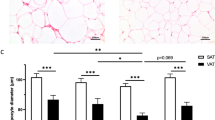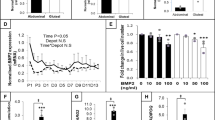Abstract
OBJECTIVE: To study the relation between body mass index (BMI) and age on the one hand and total number of human (pre-) adipocytes and preadipocyte differentiation capacity on the other hand.
SUBJECTS: In total, 189 women undergoing surgical mammary reduction, age range 16–73 y, BMI range 19.7–39.7 kg/m2.
MEASUREMENTS: Differentiation of preadipocytes in primary culture was assessed by morphological criteria, and determination of glycerol-3-phosphate dehydrogenase after stimulation of the cells by standardized adipogenic conditions containing isobutyl-methylxanthine, troglitazone or both compounds. The total number of stromal cells (ie preadipocytes) and fat cells per gram of adipose tissue and per body as well as mature fat cell volume were calculated from isolated stromal cells and adipocytes, respectively, and anthropometric measures.
RESULTS: BMI correlated positively to age, mature fat cell size and total number of adipocytes and stromal cells per body (r varying from 0.22 to 0.54, each P<0.05). In contrast, BMI correlated negatively to the number of adipocytes and stromal cells per gram of adipose tissue and the capacity of preadipocytes to differentiate (r varying from −0.20 to −0.37, each P<0.05). No significant correlation was observed between BMI and the ratio of stromal cells to adipocytes. The sample was also divided into three groups: BMI <25 kg/m2 (lean), BMI 25–29.9 kg/m2 (overweight) and BMI ≥30 kg/m2 (obese). The overweight group showed a larger fat cell size but no increase in total fat cell or stromal cell number when compared to the lean subjects. The obese subjects showed larger stromal and fat cell numbers when compared to the lean subjects. Age did not independently correlate to the number of stromal cells or adipocytes per gram of adipose tissue or total body, nor with the capacity of preadipocytes to undergo differentiation and the ratio of stromal cells to adipocytes.
CONCLUSION: There seems to be a constant ratio between the number of adipose tissue stromal cells and adipocytes independently of BMI and age in humans. During adipose tissue expansion, there seems to be both a continuous increase in fat cell size, and in stromal cell and adipocyte number, but the increase in fat cell size apparently precedes the increase in fat cell number. The differentiation capacity of the stromal cells appears to decrease with increasing BMI.
This is a preview of subscription content, access via your institution
Access options
Subscribe to this journal
Receive 12 print issues and online access
$259.00 per year
only $21.58 per issue
Buy this article
- Purchase on Springer Link
- Instant access to full article PDF
Prices may be subject to local taxes which are calculated during checkout



Similar content being viewed by others
References
Ailhaud G, Hauner H . Development of white adipose tissue. In: Dekker M, Bray GA, Bouchard C, James WPT (eds). Handbook of obesity. Marcel Dekker, New York; 1998. pp 359–378.
Salans LB, Cushman SW, Weismann RE . Studies of human adipose tissue. Adipose cell size and number in nonobese and obese patients. J Clin Invest 1973; 52: 929–941.
Knittle JL, Timmers K, Ginsberg-Fellner E, Brown RE, Katz DP . The growth of adipose tissue in children and adolescents. Cross-sectional and longitudinal studies of adipose cell-number and size. J Clin Invest 1979; 63: 239–246.
Baum D, Beck RQ, Hammer LD, Brasel JA, Greenwood MR . Adipose tissue thymidine kinase activity in man. Pediatr Res 1986; 20: 118–121.
Hauner H, Wabitsch M, Pfeiffer EE . Proliferation and differentiation of adipose tissue derived stromal-vascular cells from children of different ages. In: Björntorp P, Rössner S (eds). Obesity in Europe 88: Proceedings of the First European Congress on Obesity. Libbey: London, Paris; 1989. pp 195–200.
Hauner H, Entenmann G, Wabitsch M, Gaillard D, Ailhaud G, Negrel R, Pfeiffer EF . Promoting effect of glucocorticoids on the differentiation of human adipocyte precursor cells cultured in a chemically defined medium. J Clin Invest 1989; 84: 1663–1670.
Faust IM, Johnson PR, Stern JS, Hirsch J . Diet-induced adipocyte number increase in adult rats: a new model of obesity. Am J Physiol 1978; 235: E279–E286.
Hirsch J, Bachelor B . Adipose tissue cellularity in human obesity. Clin Endocrinol Metab 1976; 5: 299–311.
Petterson P, Van R, Karlsson M, Björntorp P . Adipocyte precursor cells in obese and nonobese humans. Metabolism 1985; 34: 808–812.
Hauner H, Wabitsch M, Pfeiffer EF . Differentiation of adipocyte precursor cells from obese and nonobese adult women and from different adipose tissue sites. Horm Metab Res Suppl 1988; 19: 35–39.
Roncari DAK, Lau DCW, Kindler S . Exaggerated replication in culture of adipocyte precursors from massively obese persons. Metabolism 1981; 30: 425–427.
Hauner H, Skurk T, Wabitsch M . Cultures of human adipose precursor cells. Methods Mol Biol 2001; 155: 239–247.
Deurenberg P, Weststrate JA, Seidell JC . Body mass index as a measure of body fatness: age- and sex-specific prediction formulas. Br J Nutr 1991; 65: 105–114.
Hauner H, Entenmann G . Regional variation of adipose differentiation in cultured stromal-vascular cells from the abdominal and femoral adipose tissue of obese women. Int J Obes Relat Metab Disord 1991; 15: 121–126.
Entenmann G, Junger E, Gries FA, Hauner H . Morphological characterization of human pre-adipocytes during in vitro adipoconversion under the control of insulin and cortisol. In: Ditschuneit H, Gries FA, Hauner H, Schusdziarra V, Wechsler JG (eds). Obesity in Europe 93: Proceedings of the Fifth European Congress on Obesity. Libbey: London, Paris; 1994. pp 59–64.
Lau DC, Shillabeer G, Wong KL, Tough SC, Russell JC . Influence of paracrine factors on preadipocyte replication and differentiation. Int J Obes Relat Metab Disord 1990; 14: 193–201.
Shillabeer G, Forden JM, Russell JC, Lau DC . Paradoxically slow preadipocyte replication and differentiation in corpulent rats. Am J Physiol 1990; 258: E368–E376.
Marques BG, Hausman DB, Martin RJ . Association of fat cell size and paracrine growth factors in development of hyperplastic obesity. Am J Physiol 1998; 275: R1898–R1908.
Janke J, Engeli S, Gorzelniak K, Luft FC, Sharma AM . Mature adipocytes inhibit in vitro differentiation of human preadipocytes via angiotensin type 1 receptors. Diabetes 2002; 51: 1699–1707.
Author information
Authors and Affiliations
Corresponding author
Rights and permissions
About this article
Cite this article
van Harmelen, V., Skurk, T., Röhrig, K. et al. Effect of BMI and age on adipose tissue cellularity and differentiation capacity in women. Int J Obes 27, 889–895 (2003). https://doi.org/10.1038/sj.ijo.0802314
Received:
Revised:
Accepted:
Published:
Issue Date:
DOI: https://doi.org/10.1038/sj.ijo.0802314
Keywords
This article is cited by
-
Activation of cell adhesion and migration is an early event of platelet-rich plasma (PRP)-dependent stimulation of human adipose-derived stem/stromal cells
Human Cell (2023)
-
“Fasting: An Effective Preconditioning Method to Increase Fat Graft Survival”
Aesthetic Plastic Surgery (2022)
-
Density-Based High-Quality Fat: Characterization and Correlation with Different Body Fat Ratio
Aesthetic Plastic Surgery (2022)
-
Obesity and hyperinsulinemia drive adipocytes to activate a cell cycle program and senesce
Nature Medicine (2021)
-
Metabolic pathways in obesity-related breast cancer
Nature Reviews Endocrinology (2021)



